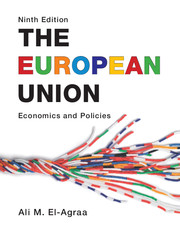Book contents
- Frontmatter
- Contents
- Figures
- Tables
- Boxes
- Contributors
- Preface
- A reader’s guide
- Abbreviations
- 1 General introduction
- Part I EU history, institutions and legal dimension
- Part II EU market integration
- 6 The theory of economic integration
- 7 The economics of the single market
- 8 Factor mobility
- 9 Measuring the economic impact of European integration
- Part III EU monetary integration
- Part IV The single European market
- Part V EU budget and structural policies
- Part VI EU external relations
- Part VII The future of the EU
- Bibliography
- Author Index
- Index
- References
7 - The economics of the single market
from Part II - EU market integration
- Frontmatter
- Contents
- Figures
- Tables
- Boxes
- Contributors
- Preface
- A reader’s guide
- Abbreviations
- 1 General introduction
- Part I EU history, institutions and legal dimension
- Part II EU market integration
- 6 The theory of economic integration
- 7 The economics of the single market
- 8 Factor mobility
- 9 Measuring the economic impact of European integration
- Part III EU monetary integration
- Part IV The single European market
- Part V EU budget and structural policies
- Part VI EU external relations
- Part VII The future of the EU
- Bibliography
- Author Index
- Index
- References
Summary
Introduction
Unlike many areas of EU policy-making, the single market, more precisely the Single European Market (SEM), has been seen in a positive light, perhaps because it has been central to EU development, although today, amid widespread disillusion with the EU, even the SEM is seen as ‘less popular than ever, more needed than ever’ (Monti 2010, p. 20). The SEM is an important stepping-stone on the route from the customs union to a fully-fledged economic union (see Chapter 1), and many regard monetary union (EMU; see Chapters 10–12) as the last stage and thus the final piece in the jigsaw of ‘negative’ integration. The SEM is defined as ‘an area without internal frontiers in which the free movement of goods persons, services and capital is ensured’ (Single European Act (SEA), Article 12; CEU 1987c). This means that borders should disappear within the EU: goods, services, capital and people should be able to move between member states (MSs) as they move between regions within a country. This requires the removal of customs and passport controls at borders; the elimination of any national barriers to the sale of other EU countries’ goods and services; and the ending of any national controls on the movement of capital. This is a very extensive agenda that has such wide implications that the subject of virtually every chapter of the book has been affected by its developments. This chapter, therefore, considers the development of the SEM, emphasizing its key characteristics and the continuing debates about its effects.
Why ‘the single market’?
There were provisions for a single market in the 1957 EEC Treaty: Article 3 required not only the removal of all internal tariffs and quotas, but also ‘of all other measures having equivalent effect’, and ‘of obstacles to freedom of movement of persons, services and capital’. The procedure to eliminate these non-tariff barriers (NTBs) was harmonization or the approximation of laws (EEC Treaty, Article 100). After the successful early completion of the customs union (see Chapter 2), internal factors and external events conspired against the completion of the single market. The EEC economy was under strain in the 1970s because of: the world recession associated with the oil price shocks of 1973 and 1979; rapid changes in technology; the changing structure of the world economy; and the emergence of significant new competitors, first Japan and then the newly industrializing countries of South East Asia. With growth slow or negative and unemployment rising rapidly, national governments tried to protect their economies, but with tariffs fixed by GATT (see Chapter 1) and EEC Treaty commitments, only NTBs could be used – the ‘New Protectionism’. Barriers went up within as well as without the EU, and these economic strains made countries much less willing to agree to integration initiatives in general and harmonization in particular.
- Type
- Chapter
- Information
- The European UnionEconomics and Policies, pp. 102 - 113Publisher: Cambridge University PressPrint publication year: 2011
References
- 2
- Cited by

